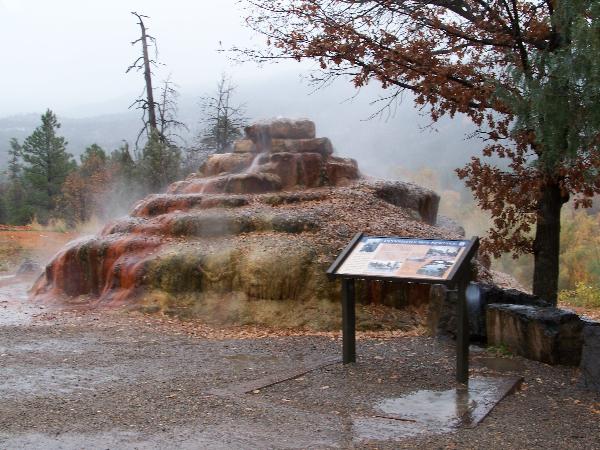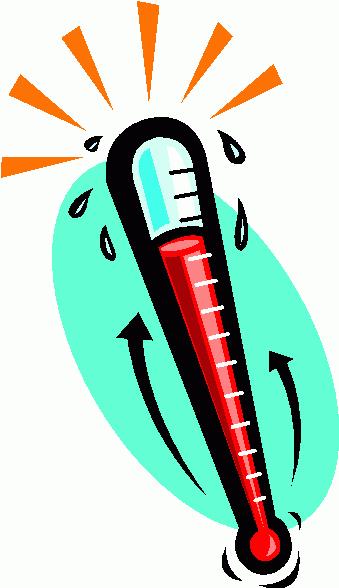 The mountains surrounding
Pinkerton Hot Springs have a geological history “as varied as
that of any mountain range in the world,”3 having geological
features formed recently (less than one million years ago) to those
formed over 1 billion years ago. They include recent, in geological
terms, localized glacial activities of
the Pleistocene Epoch (2.5 million to 12,000 years ago), recent Tertiary Period (2.5 to 65 million years ago) volcanism,
extensive Phanerozoic Eon (350 to 100 million years ago) sedimentary
formations, and Precambrian (4567 to
500 million years ago) metamorphic rock complexes.2,3
The mountains surrounding
Pinkerton Hot Springs have a geological history “as varied as
that of any mountain range in the world,”3 having geological
features formed recently (less than one million years ago) to those
formed over 1 billion years ago. They include recent, in geological
terms, localized glacial activities of
the Pleistocene Epoch (2.5 million to 12,000 years ago), recent Tertiary Period (2.5 to 65 million years ago) volcanism,
extensive Phanerozoic Eon (350 to 100 million years ago) sedimentary
formations, and Precambrian (4567 to
500 million years ago) metamorphic rock complexes.2,3
In geological terms, mountain-building activity in the area occurred recently, leaving
the earth’s crust close to the surface very warm even today. The
intrusions also faulted the sedimentary, metamorphic, and igneous rock formations that were already in the area, leaving deep
fractures into the earth. Two such faults are mapped just northeast
of the Pinkerton Hot Springs. Surface water from precipitation and runoff infiltrates through
the permeable surface soils and sedimentary
rocks, picking up minerals through dissolution on its way. Some of the water eventually finds its way
into one of these deep fractures where it encounters warm igneous
rock that was once magma. The heated water
then returns to the surface to spill out as a hot spring,
and deposits the minerals it acquired during its journey behind as
it evaporates.
 To
qualify as a hot spring, the water temperature must be warmer than
the ambient temperature of the surface soils (other definitions). Therefore, the water must reach the surface before it
cools. It achieves this by eroding a “conduit” to
the surface. The existing faults help this by providing
“cracks” that the water can easily follow to the
surface initially. The sedimentary and limestone rock
characterizing the area around Pinkerton Hot Springs serves as good
materials for such a conduit because the minerals cementing the
individual particles together that form the rock are largely
water-soluble. Once the water has eroded a conduit, it has a quick and
easy trip back to the surface, allowing it to retain much of its
heat. The water moves to the surface primarily through
heat conduction.
To
qualify as a hot spring, the water temperature must be warmer than
the ambient temperature of the surface soils (other definitions). Therefore, the water must reach the surface before it
cools. It achieves this by eroding a “conduit” to
the surface. The existing faults help this by providing
“cracks” that the water can easily follow to the
surface initially. The sedimentary and limestone rock
characterizing the area around Pinkerton Hot Springs serves as good
materials for such a conduit because the minerals cementing the
individual particles together that form the rock are largely
water-soluble. Once the water has eroded a conduit, it has a quick and
easy trip back to the surface, allowing it to retain much of its
heat. The water moves to the surface primarily through
heat conduction.
The Colorado Department of Transportation
(CDOT) modified the outflow around 2001 to
manage the water flow, keep it from affecting the
stability
of the roadway, preserve its historical value,
and maintain the hot spring environment.1,2 Thus, although
hot springs naturally form mounds, this particular mound is not a
natural formation, but is a cairn. However, the
department only “re-routed” the conduit and stacked the
rocks. Nature did the rest, including covering the mound with the
myriad of colors and shapes there today. Less than 100 yards
northwest, on the west side of the highway (N37°
27’ 11.58”,
W107°
48’ 20.87”), a natural mound
formation remains unmoved by man and it is easy to compare what
part of the fountain by the road is natural and what part is
not.
Hot springs are sought for their natural beauty, heat,
ecological diversity, and balneotherapy. Some
believe that the minerals carried in the water are beneficial to
the skin and, combined with the natural heat, can even help such
health issues as arthritis. The microclimate around
a hot spring attracts a large variety of plant and animal life not
found elsewhere in the surrounding environment, noticeably so
during the winter. Hot springs can also provide a source of energy
for commercial and residential applications, such as interior
heating.

For those technically minded folks, according to
the Department of Energy in 19811, the
Pinkerton fracture served as a geothermal reservoir
(image credit)
approximately 1,000 feet thick and covering an aerial extent of
approximately 1.2 square miles, producing an estimated total energy
on the order of 0.99x1013 to 2.09x1013
BTU’s. The energy available from this hot spring
complex is comparable to about 120 million gallons of gasoline or
14 billion cubic feet of natural gas.4 For perspective,
the average natural gas consumer uses about 319,000 cubic feet of
natural gas each year in Colorado.5 The hot springs
represent a very significant potential source of sustainable/renewable
energy.
When sampled in 1976,1 the water
temperature at the surface was 32°C
(90°F),
flowing at about 54 gallons per minute (gpm), and below the surface
was estimated to be 50°C
(122°F).
The water contained 3,700 to 3,980 parts per million (ppm, or
mg/L) dissolved solids, including minerals such as Arsenic, Boron, Cadmium, Calcium, Chloride, Fluoride, Iron, Lithium, Magnesium,
Manganese, Nitrogen, Phosphate,
Potassium, Silica, Sodium, Sulfate, Calcium Carbonate and Bicarbonate, and other noncarbonate minerals. It had a
pH balance of 6.5,
which is slightly acidic (Rainbow Trout
begin to die at pH levels of 6.0 or less4, in case you are
interested). Hot springs even contain organic life in the form
of anaerobic bacteria that help break down the minerals and, when exposed to
the surface, provide an excellent fertilizer for algae and other plant
life. Drinking the water is discouraged because its properties
probably fluctuate and it is not regularly tested for
consumption. Drinking from the spring should be
avoided.
Logging
Questions:
Based on your reading of the Colorado Scenic Byways
roadside interpretive exhibit:
1.
For what purpose was the water bottled in the
late 1800’s?
2.
What did Judge Pinkerton use the hot springs
for in the 1870’s?
Based on your observations:
3.
What specific kind of plant life is growing on
the side of the mound?
Please email your answers to the cache owner. Thanks for
visiting!
Other
Educational Information:
References:
1.
Coe, Barbara A., & Zimmerman, Judy.
(1981). Geothermal Energy Opportunities at Four Colorado Towns.
Colorado Geological Survey, Dept. of Nat. Resources, for the
USDOE.
2.
Steve, T. A., et. Al. (1974). Geologic Map of
the Durango Quadrangle, Southwestern Colorado. Department of the
Interior: United States Geological Survey. Scale:
1:250,000.
3.
Mountain Studies Institute. (n.d.). San Juan
Mountains. Available at http://www.mountainstudies.org/SanJuanMountains/.
Accessed October 20, 2009.
4.
EPA. (n.d.) pH Scale. Available at
http://www.epa.gov/acidrain/education/site_students/phscale.html.
Accessed October 20, 2009.
5.
Nave, Carl R. (2006). HyperPhysics: Energy
Unit Comparison. Online
calculator application. Availabe at http://hyperphysics.phy-astr.gsu.edu/Hbase/egex.html#eu.
Accessed October 20, 2009. Georgia University, Dept. Physics and
Astronomy.
6.
Energy Information Administration. (2007,
2008). Natural Gas Navigator: Consumption. Available at
http://tonto.eia.doe.gov/dnav/ng/ng_sum_top.asp.
Accessed October 20, 2009. Note: Total consumption for Colorado
(2008) of 504,786 million cubic feet divided by total number of
consumers (2007) of 1,583,945 = approximately 318,689 cubic feet
consumption per consumer, annually, for both residential and
commercial application.
7.
CDOT. (2010). Email conversation. CDOT guesses
the cairn was constructed in 2001, but not as part of the highway
construction.